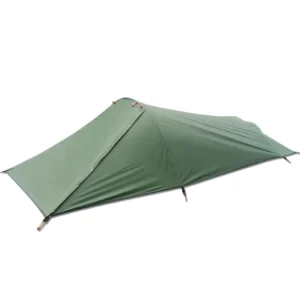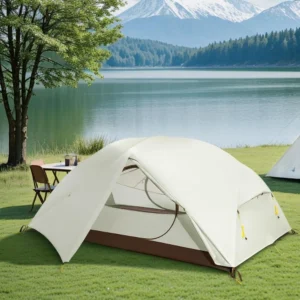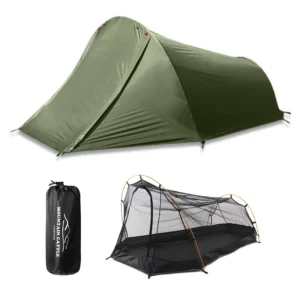Introduction
When venturing into the wilderness, your shelter becomes your home away from home—a critical piece of equipment that keeps you protected from the elements. Freestanding shelters stand apart from other options because they can stand independently without stakes or guy lines, using only their pole structure for support.
Many hikers gravitate toward freestanding shelters for hikers due to their remarkable versatility. These shelters offer distinct advantages:
- Setup on challenging surfaces like rock slabs, wooden platforms, or sandy beaches
- Easy repositioning after initial setup without complete disassembly
- Simplified setup process, especially valuable in adverse weather conditions
The right shelter can make the difference between a memorable adventure and a miserable experience, which is why understanding the various types available is essential. Throughout this guide, we’ll explore double-wall designs, single-wall options, dome-style structures, and specialized shelters for various seasons and conditions.
At Explore Elements, we’ve tested our shelters in environments ranging from desert heat to mountain snowstorms, ensuring that the advantages of freestanding shelters translate to real-world performance when you need it most.
Understanding Freestanding vs. Non-Freestanding Shelters
Before diving into specific types, it’s important to understand what truly constitutes a freestanding shelter and how it differs from other options. A genuinely freestanding shelter can stand completely on its own using only its pole structure for support. The key lies in the pole architecture—typically featuring crossing poles that create tension and structural integrity.
In contrast, freestanding vs. staked hiking shelters reveal fundamental differences in design philosophy and functionality. Semi-freestanding shelters require minimal staking (usually at the vestibule), while non-freestanding options rely entirely on stakes, trekking poles, or other external supports.
| Feature | Freestanding | Semi-Freestanding | Non-Freestanding |
|---|---|---|---|
| Setup Support | Self-supporting with poles only | Mostly self-supporting; minimal staking | Requires full staking/external support |
| Weight | Heavier (3-5 lbs/1.4-2.3 kg) | Moderate (2.5-4 lbs/1.1-1.8 kg) | Lightest (1-2.5 lbs/0.5-1.1 kg) |
| Setup Complexity | Simple, intuitive | Moderate | More complex, practice required |
| Terrain Adaptability | Excellent on any surface | Good with limitations | Limited on hard surfaces |
| Stability | Very good to excellent | Good | Depends heavily on proper staking |
A common misconception is that freestanding tents never need stakes. While they can stand independently, most perform better when properly staked out, especially in windy conditions. The differences between freestanding and non-freestanding ultralight tents become particularly important when weight is a primary concern, as each design makes different compromises between stability, versatility, and pack weight.
Double-Wall Freestanding Shelters
Double-wall freestanding shelters represent perhaps the most common and versatile design in the hiking world. As the name suggests, these shelters feature two separate components: an inner tent (typically mostly mesh with a waterproof floor) and an outer rainfly that provides weather protection.
The double-wall construction offers several significant benefits:
- Superior condensation management as moisture can escape through the inner mesh and collect on the rainfly instead of dripping onto occupants
- Versatility to use just the inner tent in dry, bug-heavy conditions
- Better temperature regulation across varying conditions
- Added protection through the dual-layer barrier
Structurally, these shelters typically use a hub-and-pole design or crossing poles that thread through sleeves or attach via clips. The inner tent attaches to this pole structure, and then the rainfly drapes over the top, creating two distinct layers with an air gap between them.
Double-wall shelters excel in varied conditions from spring through fall and in environments where temperature fluctuations and condensation are concerns. The design allows for excellent ventilation options, with the ability to roll back the rainfly partially or completely on clear nights.
While they offer superior comfort and versatility, the trade-off comes in weight and packed size. Freestanding backpacking tents in the double-wall category typically weigh between 3-5 pounds (1.4-2.3 kg), making them heavier than more minimalist options but still reasonable for most hiking trips.
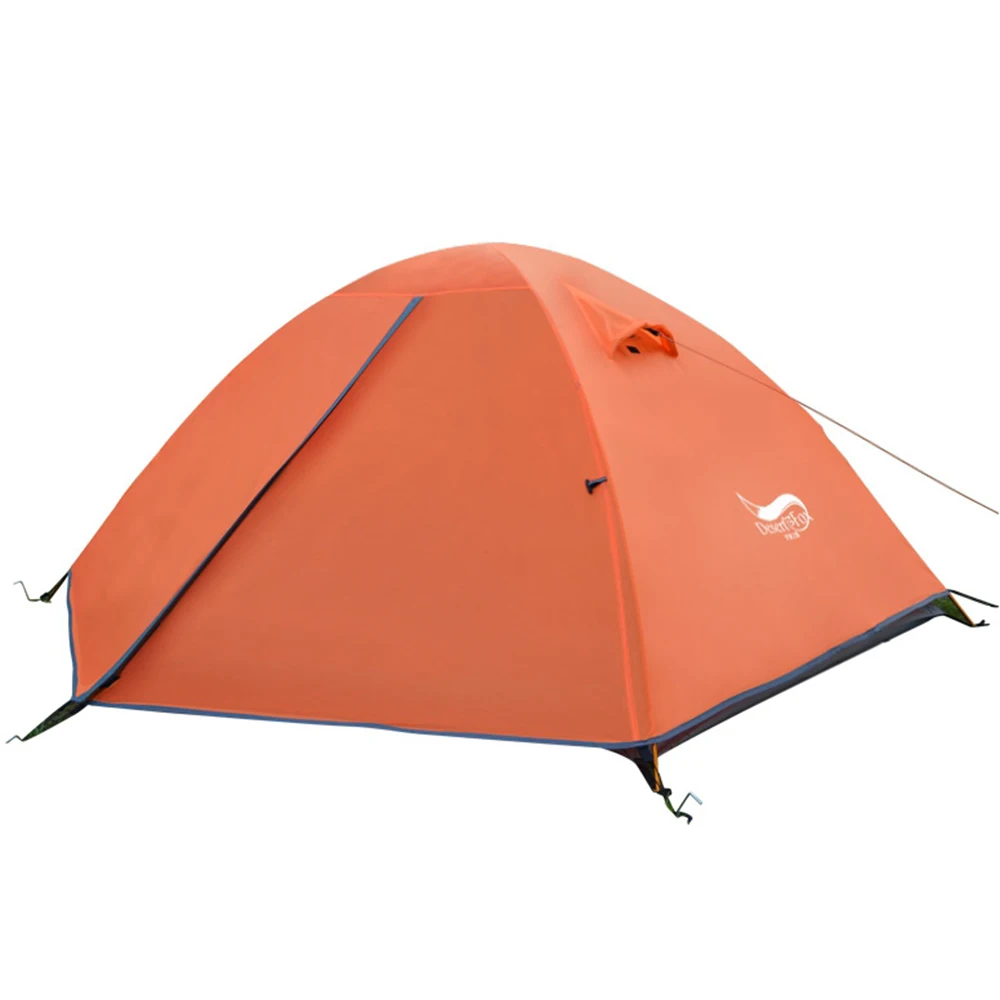
Single-Wall Freestanding Shelters
Single-wall freestanding shelters represent the more streamlined approach to shelter design, featuring just one layer of material that serves as both the tent body and weather protection. These shelters eliminate the separate rainfly, creating a simpler, lighter structure.
The most significant advantage of single-wall designs is weight reduction. By eliminating the separate rainfly, these shelters can save approximately 20-30% of the weight compared to their double-wall counterparts. This makes them particularly attractive for lightweight backpacking tent enthusiasts who prioritize reduced pack weight.
Key characteristics of single-wall freestanding shelters include:
- Integrated design where waterproof/breathable material forms the entire shelter
- Simplified setup with fewer components to assemble
- Reduced packed size
- Direct ventilation systems like awning vents, roof vents, or windows
The primary challenge with single-wall shelters is condensation management. Without the separate inner tent, moisture from breathing and body heat can more easily collect on interior surfaces. Manufacturers address this through strategic ventilation placement and advanced waterproof/breathable fabrics.
Single-wall designs particularly excel in alpine environments and colder conditions where condensation is less problematic. They’re also ideal for trips where minimizing weight is critical, such as fast-packing adventures or extended backcountry journeys where every ounce matters.
These shelters typically use high-tech materials like silnylon, silpoly, or occasionally Dyneema Composite Fabric (DCF) to achieve their lightweight status while maintaining adequate weather protection. The pole structures are often simplified compared to double-wall designs but still provide the essential freestanding capability.
Dome-Style Freestanding Shelters
Dome-style shelters represent one of the most recognizable and time-tested designs in the freestanding category. Their distinctive curved shape comes from crossing pole arches that create a hemisphere or modified dome structure.
The primary strengths of dome designs lie in their exceptional stability and weather resistance. By distributing forces evenly across the curved structure, dome tents stand up remarkably well to wind and snow loading compared to more angular designs. As wind flows over the curved surface, it creates less resistance and stress on the structure.
Dome shelters typically come in several architectural variations:
- Simple dome: Two crossing poles creating a basic hemisphere
- Extended dome: Basic dome with additional short poles to create vestibule spaces
- Geodesic dome: Multiple crossing poles creating triangulated structures for maximum stability
- Semi-geodesic: A compromise design with fewer pole crossings than full geodesic
The interior space in dome camping tents is another advantage. The curved walls create more usable volume compared to steep-walled designs, offering better headroom throughout the shelter rather than just at the center peak. This makes them particularly comfortable for extended stays or when weather forces you to spend more time inside.
While dome tents offer exceptional stability, the trade-off comes in weight. The additional pole material required for the curved structure adds ounces compared to more minimalist designs. However, for those prioritizing livability and weather performance over absolute weight savings, dome shelters provide an excellent balance.
Best 2-person dome tents remain particularly popular among hikers who frequently encounter challenging conditions, as they provide reassuring stability when the weather turns ugly without requiring advanced staking or setup skills.

Ultralight Freestanding Shelters
For weight-conscious hikers who still want the convenience of freestanding design, ultralight freestanding shelters represent the cutting edge of lightweight innovation. These specialized shelters typically weigh under 3 pounds (1.4 kg)—significantly lighter than traditional freestanding designs while retaining their fundamental self-supporting capability.
Ultralight freestanding tents achieve their weight reduction through several key innovations:
- Premium materials like ultra-thin nylons and polyesters (often 10-20 denier)
- Carbon fiber pole structures instead of aluminum
- Strategic minimalism in features and dimensions
- Hybrid single/double-wall designs that reduce fabric requirements
- Simplified ventilation and entrance designs
- Ultralight components (lighter zippers, cordage, and hardware)
The material science behind these shelters is impressive, with fabrics that balance minimal weight with adequate durability. However, this weight reduction does come with trade-offs. The ultra-thin materials require more careful handling to prevent punctures and tears. The lifespan of these shelters is typically shorter than their heavier counterparts, and they often command a significant price premium for the weight savings.
Despite these considerations, ultralight freestanding shelters fill an important niche. They’re ideal for long-distance hikers who want to reduce weight without sacrificing the convenience of freestanding setup. They’re also excellent for trips with varied terrain where non-freestanding shelters might struggle.
Maximizing space and comfort becomes particularly important in ultralight designs, where interior dimensions are often reduced to save weight. Clever architectural solutions like pre-bent poles and strategic sidewall designs help create more livable spaces despite the weight constraints.
3-Season Freestanding Shelters
The 3-season freestanding shelter is the most versatile and common category, designed to handle conditions from spring through fall in most hiking environments. These balanced designs aim to provide adequate weather protection while maintaining reasonable weight and excellent ventilation.
Typical 3-season shelters feature:
- Generous mesh panels in the inner tent body for ventilation and condensation control
- Moderate waterproofing ratings (typically 1500-3000mm hydrostatic head)
- Lighter pole structures suitable for moderate wind conditions
- Vestibule space for gear storage
- Multiple doors for convenience (in 2+ person models)
- Balance of weather protection and weight savings
These shelters excel in temperatures ranging from near freezing to warm summer conditions. They handle light to moderate rainfall effectively and can withstand typical wind conditions found below alpine elevations. The ventilation-focused design makes them particularly comfortable in warmer weather when condensation can become problematic in less breathable shelters.
Ultralight backpacking tents in the 3-season category represent the sweet spot for most hikers, balancing protection and weight in a way that serves the majority of backpacking scenarios. They typically weigh between 2.5-4 pounds (1.1-1.8 kg) for a two-person model, making them reasonable to carry while providing comfortable living space.
The versatility of 3-season shelters makes them an excellent first tent for those getting into hiking, as they cover the conditions most recreational hikers will encounter on weekend trips and summer adventures. Only those regularly venturing out in winter or at high elevations will need more specialized protection.
Extended-Season (3+ Season) Freestanding Shelters
For hikers who venture out beyond the comfort of summer conditions but aren’t facing full winter expeditions, extended-season shelters (often called 3+ season) provide a valuable middle ground between standard 3-season and full 4-season designs.
Extended-season shelters incorporate additional structural and material elements to handle more challenging conditions:
- Reduced mesh in the tent body, with more solid fabric for warmth retention
- Additional pole crossings or stronger pole segments for improved stability
- Lower, more aerodynamic profiles to better shed wind
- Enhanced rainfly coverage with smaller vestibules that block wind more effectively
- Reinforced stake points and guy-out options for secure pitching
These designs excel in the “shoulder seasons” of late fall and early spring, as well as summer trips to alpine environments where conditions can deteriorate quickly. They’re also suitable for mild winter camping at lower elevations where heavy snow loads aren’t expected.
The weight penalty for this additional protection is relatively modest—typically adding 8-16 oz (225-450g) compared to standard 3-season equivalents. This makes extended-season shelters attractive for hikers who occasionally push into more demanding conditions but don’t want to carry a full mountaineering tent.
Freestanding tent structure becomes particularly important in these extended-season designs, as the pole architecture must balance increased strength without excessive weight. Many feature modified dome designs or additional hub segments that create more rigid, stable shapes when facing stronger winds.
4-Season (Winter/Mountaineering) Freestanding Shelters
When facing the harshest conditions nature offers—winter storms, alpine environments, and extreme weather—4-season freestanding shelters provide the robust protection necessary for safety and comfort. These specialized shelters are engineered specifically for severe weather resistance rather than weight savings.
Heavy duty 4-season tents feature significant structural enhancements:
- Full geodesic or semi-geodesic pole structures with multiple crossing points
- Heavier, stronger pole materials (often aluminum alloys with larger diameters)
- Minimal mesh, with mostly solid fabric walls to retain warmth
- Reinforced anchor points for securing against high winds
- Specialized features like snow skirts and reinforced guy-out points
- Steeper wall angles to shed snow more effectively
The fabric choices for 4-season shelters prioritize durability and weather resistance over weight savings. Higher denier fabrics (often 50-70D) with robust waterproof coatings (typically 3000-5000mm hydrostatic head) ensure these shelters can withstand driving snow and rain without failure.
While 4-season shelters excel in harsh conditions, they carry significant weight penalties. Two-person models typically weigh between 6-9 pounds (2.7-4.1 kg)—considerably heavier than their 3-season counterparts. This additional weight comes from the reinforced materials, additional poles, and more substantial construction throughout.
Ventilation becomes a critical consideration in these more enclosed designs, as the reduced mesh means condensation can build up more quickly. Manufacturers address this with adjustable vents strategically positioned to create airflow without allowing snow intrusion.
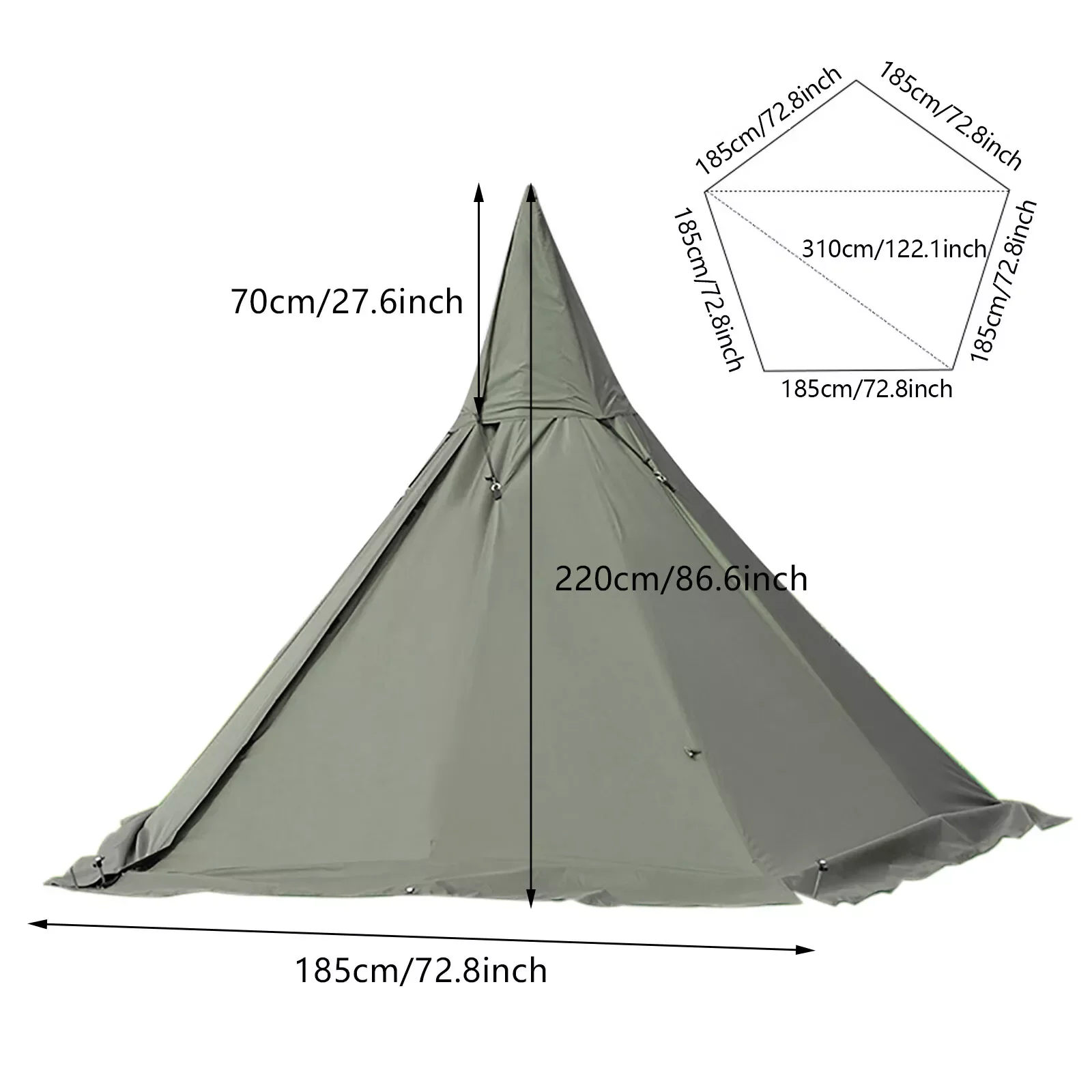
Key Features to Compare Across Freestanding Shelter Types
When evaluating different freestanding shelter options, several key features determine their performance, comfort, and suitability for various conditions. Understanding these elements helps you make informed comparisons between different models.
Pole Architecture and Materials
Pole design fundamentally defines a shelter’s strength and stability. Aluminum poles (typically 7000-series aluminum) offer the best balance of strength and weight, while carbon fiber provides weight savings at a higher cost and slightly reduced durability. The configuration matters as much as the material—hub designs, number of crossing points, and pole diameter all influence performance.
Fabric Technology
Modern shelter fabrics balance multiple properties:
* Denier rating (thickness/durability): Higher numbers mean greater durability but more weight
* Waterproof rating (hydrostatic head): Typically 1200-5000mm, with higher numbers indicating better water resistance
* Silicone vs. polyurethane coatings: Silicone offers better durability and water repellency but at higher cost
Floor Space and Dimensions
While the square footage tells part of the story, the shape matters significantly. Freestanding hiking tents design features often include:
* Floor dimensions (length × width)
* Peak height (center and edge heights)
* Wall angles (steeper walls create more usable space)
* Vestibule area (additional protected space for gear)
Weather Protection
Beyond just staying dry, understanding tent waterproof ratings and overall weather resistance involves:
* Wind stability (pole structure and stake-out options)
* Rainfly coverage (full coverage vs. partial coverage)
* Snow-loading capability (particularly for 4-season shelters)
* Guy-out options for additional stability
Ventilation Systems
Effective condensation management requires thoughtful ventilation:
* Mesh panels location and size
* Adjustable vents in the rainfly
* Door positioning for cross-ventilation
* Vestibule configuration for airflow
Packed Size and Weight
The portability of a shelter depends on:
* Trail weight (shelter, poles, minimum stakes)
* Packed size (how much space it occupies in your pack)
* Component separation options (ability to split between hikers)
Lightweight Backpacking Tent, Ultralight Backpacking Tent, Ultralight Bivy Tent
Ultralight Single Person Camping Tent with Aluminum Poles for 3-Season Backpacking Waterproof DesignPrice range: $94.88 through $326.82 Select options This product has multiple variants. The options may be chosen on the product pageLightweight Backpacking Tent, Ultralight Backpacking Tent, Waterproof Backpacking Tent
$391.05 Select options This product has multiple variants. The options may be chosen on the product pageHeavy Duty 4 Season Tent, Mountaineering Tent, Winter Camping Tent
$870.40 Select options This product has multiple variants. The options may be chosen on the product pageCompact Backpacking Tent, Lightweight Backpacking Tent, Waterproof Camping Tent
$335.52 Select options This product has multiple variants. The options may be chosen on the product pageUltralight Backpacking Tent, Ultralight Dome Tent, Winter Camping Tent
Price range: $369.63 through $370.07 Select options This product has multiple variants. The options may be chosen on the product pageHeavy Duty 4 Season Tent, Ultralight Freestanding Tent, Winter Camping Tent
$3,722.66 Select options This product has multiple variants. The options may be chosen on the product page
How to Choose the Right Freestanding Shelter for Your Hiking Needs
Selecting the ideal freestanding shelter requires aligning your specific needs with the strengths of different designs. Consider the following factors to guide your decision:
Environmental Considerations
Start by honestly assessing where and when you’ll be hiking most frequently:
* If you primarily hike in summer conditions below alpine elevations, a standard 3-season shelter offers the best balance.
* For those venturing into shoulder seasons or occasional high-altitude summer trips, an extended-season design provides additional security.
* Winter adventurers and mountaineers should invest in a proper 4-season shelter despite the weight penalty.
Weight Priority Assessment
Determine where weight falls in your personal hierarchy of needs:
* Ultralight enthusiasts and long-distance hikers might prioritize a lighter single-wall or specialized ultralight design.
* Weekend backpackers may prefer the comfort and durability of a slightly heavier double-wall shelter.
* Groups can distribute components among members to mitigate individual weight concerns.
Space Requirements
Consider your spatial needs honestly:
* Solo hikers may find a 1-person shelter sufficient, though many solo hikers prefer 2-person designs for additional comfort.
* Partners should consider how much time they’ll spend in the shelter beyond sleeping—more time inside justifies a larger floor plan.
* Factor in gear storage needs, especially for longer trips or equipment-heavy activities like climbing.
Budget Reality
Quality freestanding shelters represent a significant investment:
* Entry-level options start around $200-250 but may compromise on materials or features
* Mid-range shelters ($300-400) offer a good balance for most recreational hikers
* Premium options ($400-700+) provide weight savings, durability advantages, or specialized features
When comparing options, the best freestanding hiking shelters typically offer the right balance between these factors for your particular needs rather than excelling in every category.
The essential features of winter hiking shelters become particularly important if you’ll be venturing out in colder conditions, where shelter choice directly impacts safety.
Advantages of Investing in a Quality Freestanding Shelter
Purchasing a premium freestanding shelter represents a significant upfront investment, but the long-term benefits often justify the initial cost.
Quality shelters offer substantial durability advantages. Higher-grade materials, precision manufacturing, and thorough testing result in shelters that maintain their performance characteristics for years rather than seasons. This longevity means a quality shelter often costs less per trip over its lifetime than repeatedly replacing cheaper alternatives.
Performance in challenging conditions represents another critical advantage. When unexpected weather strikes, the mastering wind stability in freestanding tents becomes essential for both comfort and safety. Premium shelters maintain their integrity in conditions that might compromise budget options.
Additional benefits of investing in quality include:
- Reliable waterproofing that doesn’t degrade rapidly with use
- Poles that maintain their strength and shape over time
- Zippers and hardware that continue functioning smoothly after extended use
- Better warranty support and repair options from established manufacturers
- Higher resale value if your needs change
For consistent hikers who rely on their gear in varied conditions, a quality shelter provides peace of mind that can’t be measured purely in dollars. Knowing your shelter will perform when needed most—during unexpected storms or challenging conditions—adds an intangible value to every trip.
FAQ: Common Questions About Freestanding Hiking Shelters
Are freestanding shelters worth the extra weight?
For most hikers, yes. The versatility, ease of setup, and ability to pitch on any surface make the modest weight penalty (typically 8-16 oz/225-450g compared to non-freestanding equivalents) worthwhile. The convenience becomes particularly valuable in adverse conditions or when camping on challenging surfaces.
How much more do freestanding shelters typically weigh than non-freestanding options?
Freestanding shelters typically weigh 20-30% more than their non-freestanding counterparts in the same category. For example, a 2-person freestanding ultralight tent might weigh 2.5 pounds (1.1 kg), while a comparable non-freestanding design might weigh 1.8 pounds (0.8 kg).
Can freestanding shelters work without any stakes at all?
Yes, genuinely freestanding shelters can stand on their own without stakes. However, in windy conditions, staking is still highly recommended for stability. Additionally, features like vestibules often require staking to function properly, even on freestanding designs.
What’s the difference between semi-freestanding and fully freestanding?
Fully freestanding shelters stand completely on their own with no staking required for the main structure. Semi-freestanding designs require minimal staking (typically at the vestibule or foot end) to achieve their full shape and stability, but still use poles for primary support.
Are single-wall or double-wall freestanding shelters better for condensation?
Double-wall designs generally manage condensation better. The separate inner tent allows moisture to pass through to the rainfly, where it can collect without dripping onto occupants. Single-wall designs require more active ventilation management to control condensation effectively.
How do freestanding shelters perform in high winds compared to non-freestanding options?
When properly staked, high-quality freestanding hiking shelters often outperform non-freestanding options in wind resistance. Their integrated pole structures create more stable, self-supporting frameworks that maintain their shape under pressure. Non-freestanding shelters rely entirely on tension from stakes and guy lines, which can fail more easily if any single anchor point gives way.


